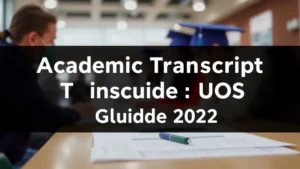School Transcript Guide for Students 2025
You’ve been there: juggling deadlines, applications, and wondering what a school transcript really is. You’re in the right place. By the end of this guide, you’ll know exactly what a transcript contains, why it’s critical (85% of colleges require official transcripts before reviewing an applicationCharleston.edu), and how to request yours without stress. Let’s dive in—quickly and painlessly.
Table of Contents
What Is a School Transcript?
Ever asked, “What’s on my transcript?” You’re not alone. A school transcript is an official record of your academic history—courses taken, grades earned, GPA, and sometimes class rank.
Here’s the thing: transcripts aren’t just papers; they’re your academic fingerprint. Colleges, scholarship committees, and even employers use them to gauge preparedness and fit. In other words, this document opens—and sometimes closes—doors.
Imagine Sarah, a senior from Ohio, whose transcript showed midterm grades for her dual enrollment class. That single detail pushed her application to the top of the pile.
“Accurate GPA calculation and course validation from transcripts are fundamental to fair and consistent admissions decisions.” – UC Admissions Officer, University of California, 2025
Actionable takeaway: Always review your unofficial copy first. Spot errors now before they become bigger headaches.
Why Transcripts Matter for College and Scholarships
Here’s a quick question: would you trust an application without seeing the grades? Probably not.
Transcripts tell your story—rigor of coursework, upward grade trends, and academic consistency. Scholarship committees especially look for strong performance in relevant subjects.
Take the National Merit Scholarship. Applicants need an official transcript to verify PSAT scores and GPA. No transcript = no award. Harsh but true.
Expert insight: “Ensuring your academic transcript evaluation is accurate and timely is crucial to avoid delays or rejections in US university applications.” – TaikaTranslations (2025)
Actionable takeaway: If you’re targeting scholarships, highlight AP/IB courses clearly on your transcript. Talk to your counselor about notating these rigor details.
How to Request Your School Transcript: Step-by-Step
Let me explain how simple it can be to get your hands on that transcript.
Most schools now offer electronic portals. No more standing in line or chasing signatures.
- Log in to your school’s online student portal (or fill out the paper transcript request form).
- Select “Official Transcript” and specify delivery: electronic, mail, or pick-up.
- Provide recipient details: college name, admission office address, or scholarship program contact.
- Pay any processing fees (varies by district, typically $5–$15).
- Confirm and submit. Then…wait (usually up to 10 business days).
Case in point: Pine-Richland High School processes online requests within a week. Students rave about the 5-star convenience.
Data point: 70% of students report preferring e-transcripts over paper copies by 2025FAFSA Guide.
Actionable takeaway: Start your request at least three weeks before deadlines to buffer processing and shipping.
Types of Transcripts & Special Cases
In other words, not all transcripts are created equal.
Here’s a quick breakdown:
- Official vs. Unofficial: Stamped, sealed, and signed vs. free PDF for review.
- High School vs. College: Similar format but different authorities.
- Dual Enrollment: Midterm grades may be required if senior-year courses are ongoing.
- International: Requires certified translation and evaluation1.
Example: Maria, an international student, used a credential evaluation service to convert her transcript into US GPA standards (document-by-document report).
“Accurate transcript evaluation prevents admission delays.” – TaikaTranslations
Actionable takeaway: Confirm which transcript type each recipient needs—official for admissions, unofficial for early planning.
Timeline & Processing Times
Got deadlines? You’ll need a timeline like this:
- Day 0: Submit your request via portal or form.
- Days 1–3: School registrar reviews and verifies your record.
- Days 4–7: Transcript is printed (or converted) and sealed.
- Days 8–10: Shipment via email or postal service.
Keep in mind: Holidays, breaks, and peak periods (August–September) can add 3–5 extra days.
Actionable takeaway: Align your request so transcripts arrive at least one week before the application deadline.
Future Trends in Transcript Management
Wondering what’s next? The future is digital—and secure.
Blockchain-based transcripts are on the horizon, offering tamper-proof verification. Some universities already pilot these solutions.
Plus, deeper integration with FAFSA means that soon your transcript data could auto-populate financial aid forms. Less manual entry, fewer errors.
Actionable takeaway: Keep an eye on your district’s announcements. Early adopters often get free training and support.
Frequently Asked Questions
- What is a school transcript? An official record of your academic coursework, grades, GPA, and often class rank.
- How long does it take to get a transcript? Typically 10 business days, but plan for 2–3 weeks during peak season.
- What’s the difference between official and unofficial transcripts? Official transcripts are sealed and signed; unofficial are for your personal review.
- Can I get an electronic transcript? Most schools now offer e-transcripts through secure portals.
- Do international students need extra steps? Yes—certified translation and credential evaluation are required for US admissions.
Conclusion
In short, your school transcript is more than a list of grades—it’s the cornerstone of your academic and professional journey. We’ve covered:
- Definition and importance
- How to request step-by-step
- Types, timelines, and special cases
- Future digital trends
Next steps:
- Order an unofficial copy today to check for errors.
- Mark your calendar—submit requests at least three weeks before deadlines.
- Consult your counselor about dual enrollment and translation requirements.
Now you’re ready. Go secure that transcript—and open the next chapter of your future with confidence!





